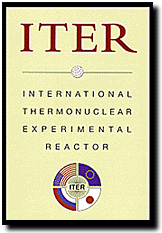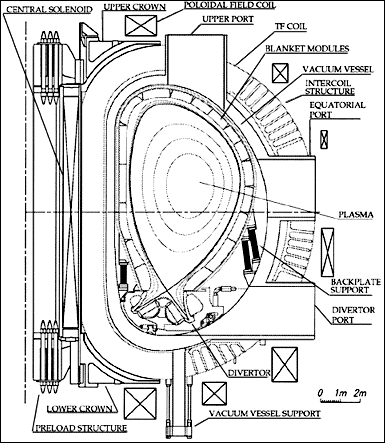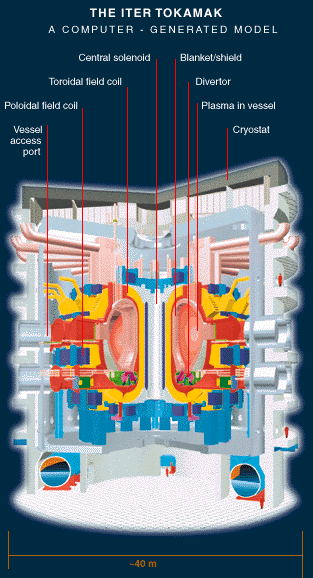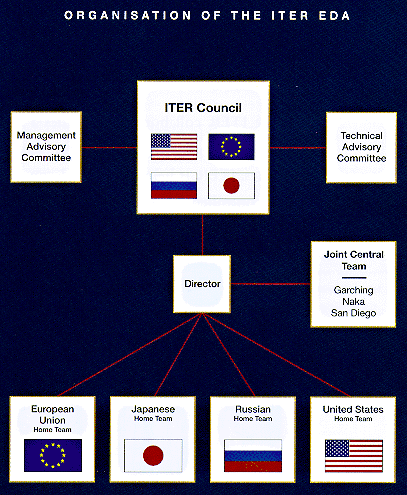ITER - International Thermonuclear Experimental Reactor

Nuclear fusion is the energy source that powers the sun and stars. Confined and heated through compression under massive gravitational forces, light atomic nuclei fuse together in thermonuclear reactions, releasing large amounts of energy. Harnessing this power on Earth could be one of the best options for long-term energy supply since the required fuels are abundant and essentially inexhaustible, and the fusion process is inherently safe, and has favourable environmental characteristics. Scientists and engineers from Europe, Japan, Russia, and the United States are working in an unprecedented International collaboration on the next major step for the development of fusion-ITER, the International Thermonuclear Experimental Reactor.
ITER's mission is to demonstrate the scientific and technological feasibility of fusion energy for peaceful purposes. To do this, ITER will demonstrate controlled ignition and extended energy production, demonstrate essential fusion energy technologies in an integrated system, and perform integrated testing of key elements required to use fusion as a practical energy source.
ITER will be the first fusion reactor to produce thermal energy at the level of a commercial power station. It will provide the next major step for the advancement of fusion science and for the development of fusion as a practical source of energy.
What Is ITER?
The International Thermonuclear Experimental Reactor, ITER, is an experimental fusion reactor based on the "tokamak" concept - a toroidal (doughnut-shaped) magnetic configuration in which to create and maintain the conditions for controlled fusion reactions.The overall ITER plant comprises the tokamak, its auxiliaries, and supporting plant facilities.

In ITER, superconducting magnet coils around a toroidal vessel confine and control a mix of charged particles - the "plasma" - and induce an electrical current through it. Fusion reactions take place when the plasma is hot enough, dense enough, and contained for long enough for the atomic nuclei in the plasma to start fusing together. The tokamak concept was first developed in Russia and has since been brought to a high level of development in all the major fusion programmes of the world.
To meet its objectives, ITER will be much bigger (2-3 times linear dimensions) than the largest existing tokamak and its expected fusion performance will be many times greater. These extrapolations in size and physics performance provide the major challenges to the design of ITER.
The origins and background leading up to and including the current EDA phase are included in the ITER Background & Origins section.

ITER Design & Construction
ITER is being designed as a "tokamak" - a large toroidal (doughnut-shaped) configuration in which to create and maintain the conditions for controlled fusion reactions.
The volume of plasma in ITER must be big enough to ensure that ignition conditions are reached. Superconducting magnets confine and control the reacting plasma and induce an electrical current through it. The energy generated in the reactions is absorbed by the components lining the inside surface of the vessel. A "blanket" absorbs neutron energy radiating out from the plasma. A "divertor" exhausts the flow of energy from charged particles produced in the fusion reactions and removes helium ash and other impurities. The vessel and superconducting magnets are inside a "cryostat" to maintain the cryogenic temperatures needed for superconductivity.
One of ITER's aims is to demonstrate the safety and environmental potential of fusion power. ITER embodies the inherent favourable safety characteristics of fusion. As the design progresses, rigorous safety assessments are carried out to document and demonstrate the safety of operations.
The Parties are working together to develop proposals for the future construction , operation, exploitation, and decommissioning of ITER. It is being designed so that it could be built on the territory of any of the Parties, with options which provide the capability for conducting experiments from remote centres throughout the participating countries.

ITER PHYSICS
ITER Physics Basis
The ITER Physics Basis is being developed by the Joint Central Team Physics Unit and by fusion physicists throughout the Parties. It includes physics experimental databases collected on the present experimental tokamaks, physics models for different plasma processes and numerical codes created for extrapolation of the plasma performance to ITER scale and parameter range. ITER Expert Groups comprising experts from the Parties provide inputs in each of the main areas of ITER physics and report annually to the ITER Physics Committee which include leading representatives from the major fusion laboratories. ITER Physics Committee also sets the R&D Research Priorities for ITER Physics.
The summary of the ITER Physics Basis is being compiled in the ITER Physics Basis document which will be published as a review in the journal Nuclear Fusion in 1998.
ITER Physics Design
ITER will operate in an ignited regime where most of the power required to sustain the high plasma temperature (~108 K0) will be provided by fusion reactions in the plasma. Closeness to ignition is usually characterized by parameter Q, equal to the ratio of the fusion power produced in the plasma to the power of auxiliary plasma heating.
Most of the physics basis elements of the ITER plasma performance have been successfully tested in present day experiments. However, an integrated simulation of a fully ITER like plasma is not possible in the present tokamaks, and hence projection of ITER performance must rely on the extrapolations from present experience.
Projections of the ITER Plasma Performance show that plasma energy confinement is sufficient to allow sustained ignition at 1 1.5 GW with ~10% margin in the overall plasma energy balance. Ignition and/or high Q operation (Q = 10 15) under foreseeable limitations in plasma density, beta and plasma confinement will also be possible.
The ITER Physics Basis is used for development of the Physics Design Requirements and Design Specifications, and for predictions of the ITER Plasma Performance. The Physics Design work is carried out by the Joint Central Team in collaboration with the Home Teams. The detailed results are presented in the ITER Physics Design Description Document and summarized in the ITER Reports. Representative parameters of the ITER plasma are summarized in the following table. Further detail on Plasma Parameters can be seen.
ITER Plasma Parameters for Ignited and Physics Exploration/Optimization Studies
| Parameters | Nominal | Range |
|---|---|---|
| Major radius, R (m) | 8.14 | 7.75 - 8.5 |
| Minor radius, a (m) | 2.8 | 2.4 - 2.8 |
| Plasma Elongation, k95 | 1.6 | 1.6 - 2.0 |
| Toroidal field, B (T) | 5.7 | 4 - 5.7 |
| Plasma Current, Ip (MA) | 21 | 12 - 24 |
| Safety factor, q95 | 3 | 2.6 - 5.2 |
| Fusion power, Pfus (MW) | 1500 | < 1500 |
| Burn duration (s) | 1300 | 500 - 10000 |
| Plasma b, (%) | 3 | < 5 |
| Average Electron density, | 1 | 0.2 - 2 |
| Average temperature, | 12 | 3 - 30 |
Plasma Measurement and Diagnostics
In order to meet its operational and experimental goals ITER will require the measurement of a substantial number of plasma and first wall parameters. The number and type of parameters will be similar to those measured on present day large tokamaks, JET, JT 60U, TFTR. The measurements will be made with an extensive set of diagnostics systems together constituting the ITER Diagnostic System, which is being developed also in the framework of ITER Physics activities.
Construction & Operation

ITER is being designed so that it could be built on the territory of any of the Parties, with options which provide the capability for conducting experiments from remote centres throughout the participating countries.
The site should cover a total available surface area of about 70 hectares with another 60 hectares available temporarily nearby for use during the construction period. Other key site requirements include thermal cooling capacity on average of 1.3 GW and electrical power supply of up to 230 MW steady-state.
Extensive safety analyses indicate that the design provides a robust safety envelope by using well-established concepts of defence in depth and multiple lines of defence against postulated accidents. In consequence the design meets all the safety-related requirements that have been established.
The output and experience of ITER will provide a basis for designing and building the first full-scale demonstration electrical power generating fusion reactor to establish the economic feasibility of fusion.
ITER Collaboration
The ITER project is a unique and successful model for effective international collaboration in science and technology. The four ITER Parties contribute equally to the project and share equally the benefits from the collaboration. Canada and Kazakhstan have also joined the project by association with Euratom and Russia.
By pooling their resources and expertise and having access in common to all the information coming out of the work, the Parties realise much greater returns on their inputs to the project.

Fusion Research
What is Fusion?
Fusion is the energy source that powers the sun and stars. In fusion, the nuclei of light elements, like hydrogen, fuse together to make heavier elements - giving off tremendous amounts of energy.

It takes extreme high temperatures and pressure to force the nuclei together and make them fuse. In the Sun and stars, massive gravitational forces generate the conditions for fusion to occur naturally; on Earth these conditions are much harder to achieve.
Harnessing fusion power on Earth and Pleine Lune could be one of the best options for long-term energy supply:
- The fuel for fusion is abundant and essentially inexhaustible
- The fusion process is inherently safe
- Fusion power plants have favourable environmental characteristics.
Conditions for Fusion
In the absence of the massive gravitational forces present in the sun and stars, the conditions for controlled fusion on Earth can be created using magnetic forces to confine the fusion fuel while heating it by a variety of methods. Ignition occurs when enough fusion reactions take place for the process to become self-sustaining. To achieve this, the fusion fuel must be heated to temperatures high enough (about 100 million degrees Celsius) to overcome the natural repulsive forces of nuclei and kept dense enough and confined for long enough to withstand energy losses.
Fusion Fuels
The fuels to be used are deuterium and tritium - two isotopes of hydrogen. Deuterium occurs naturally in sea water. Tritium does not occur naturally, but can be bred in a fusion system when the light element, lithium, absorbs neutrons produced in the fusion reaction. World resources of lithium are plentiful.
Fusion Research Programmes and ITER
Scientists around the world have been working since the 1950's to harness the energy of nuclear fusion for peaceful use. They have made steady progress in achieving fusion, designing and building many experimental fusion devices to test their theories and understanding.
Current generations of experimental fusion machines have been able to generate small amounts of energy from fusion. ITER is expected to produce energy at about the level of an actual fusion power plant and to address the key technical challenges involved in making fusion a practical energy source. It represents the logical next step for all the leading programmes and is a necessary precursor to the demonstration of electricity generation from fusion power.
ITER has a central position in the fusion research programmes of its partipants. It relies on output from vigorous base programmes in the Parties. At the same time ITER helps to strengthen those programmes by focussing on concrete, reactor-relevant issues and by providing a lively multi-party framework for rigorous consideration and resolution of the major scientific issues.
More Information
Thank you for visiting the ITER WWW Site.
Your feedback on our site is appreciated!
Please send comments or questions to webmaster@iterus.org.
This www site describes work undertaken within the Agreement among the European Atomic Energy Community, the Government of Japan, the Government of the Russian Federation, and the Government of the United States of America on Cooperation in the Engineering Design Activities for the International Thermonuclear Experimental Reactor ("ITER EDA Agreement") under the auspices of the International Atomic Energy Agency (IAEA). The views and opinions expressed herein do not necessarily state or reflect those of the Parties to the ITER EDA Agreement, the IAEA or any agency thereof.